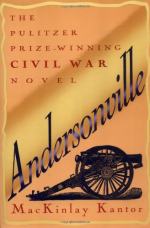The pen was longest due north and south. It was divided in the center by a creek about a yard wide and ten inches deep, running from west to east. On each side of this was a quaking bog of slimy ooze one hundred and fifty feet wide, and so yielding that one attempting to walk upon it would sink to the waist. From this swamp the sand-hills sloped north and south to the stockade. All the trees inside the stockade, save two, had been cut down and used in its construction. All the rank vegetation of the swamp had also been cut off.
There were two entrances to the stockade, one on each side of the creek, midway between it and the ends, and called respectively the “North Gate” and the “South Gate.” These were constructed double, by building smaller stockades around them on the outside, with another set of gates. When prisoners or wagons with rations were brought in, they were first brought inside the outer gates, which were carefully secured, before the inner gates were opened. This was done to prevent the gates being carried by a rush by those confined inside.
At regular intervals along the palisades were little perches, upon which stood guards, who overlooked the whole inside of the prison.
The only view we had of the outside was that obtained by looking from the highest points of the North or South Sides across the depression where the stockade crossed the swamp. In this way we could see about forty acres at a time of the adjoining woodland, or say one hundred and sixty acres altogether, and this meager landscape had to content us for the next half year.
Before our inspection was finished, a wagon drove in with rations, and a quart of meal, a sweet potato and a few ounces of salt beef were issued to each one of us.
In a few minutes we were all hard at work preparing our first meal in Andersonville. The debris of the forest left a temporary abundance of fuel, and we had already a cheerful fire blazing for every little squad. There were a number of tobacco presses in the rooms we occupied in Richmond, and to each of these was a quantity of sheets of tin, evidently used to put between the layers of tobacco. The deft hands of the mechanics among us bent these up into square pans, which were real handy cooking utensils, holding about—a quart. Water was carried in them from the creek; the meal mixed in them to a dough, or else boiled as mush in the same vessels; the potatoes were boiled; and their final service was to hold a little meal to be carefully browned, and




